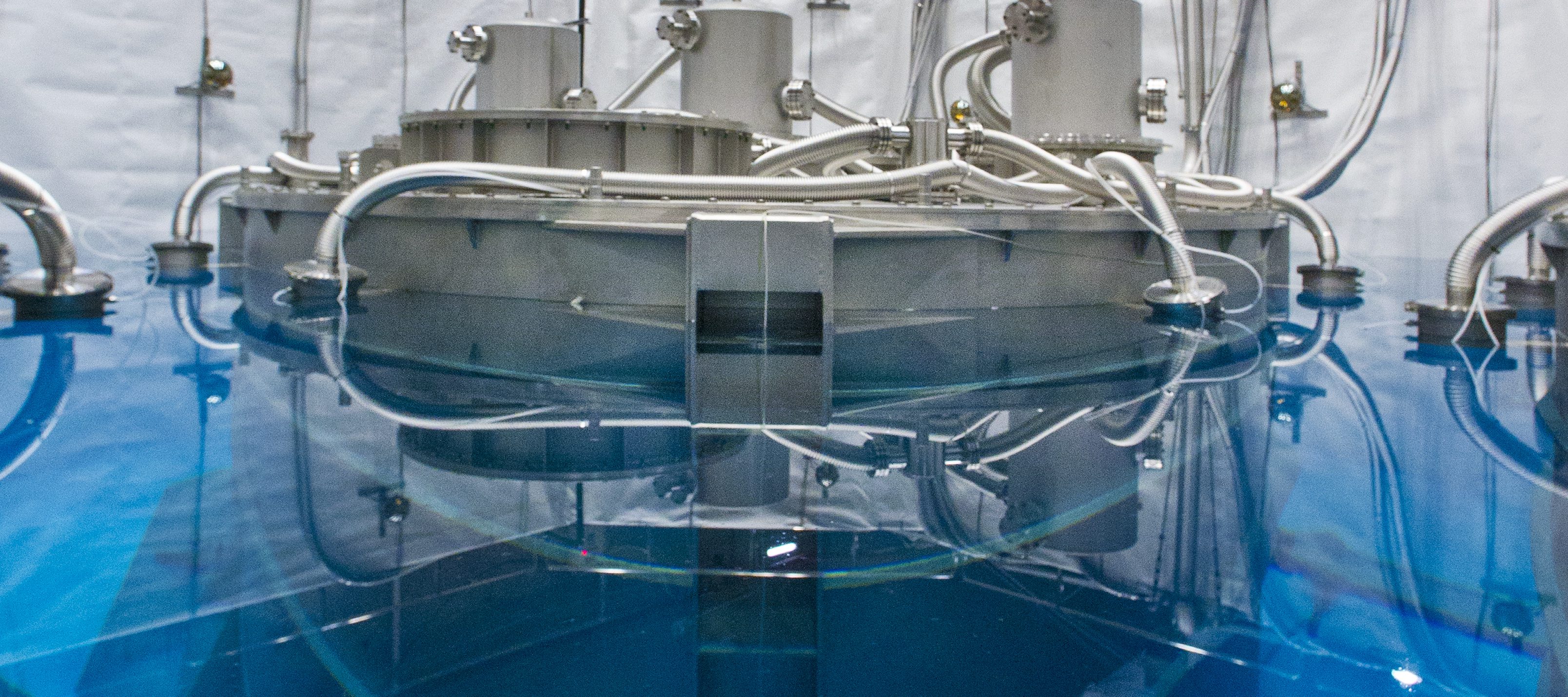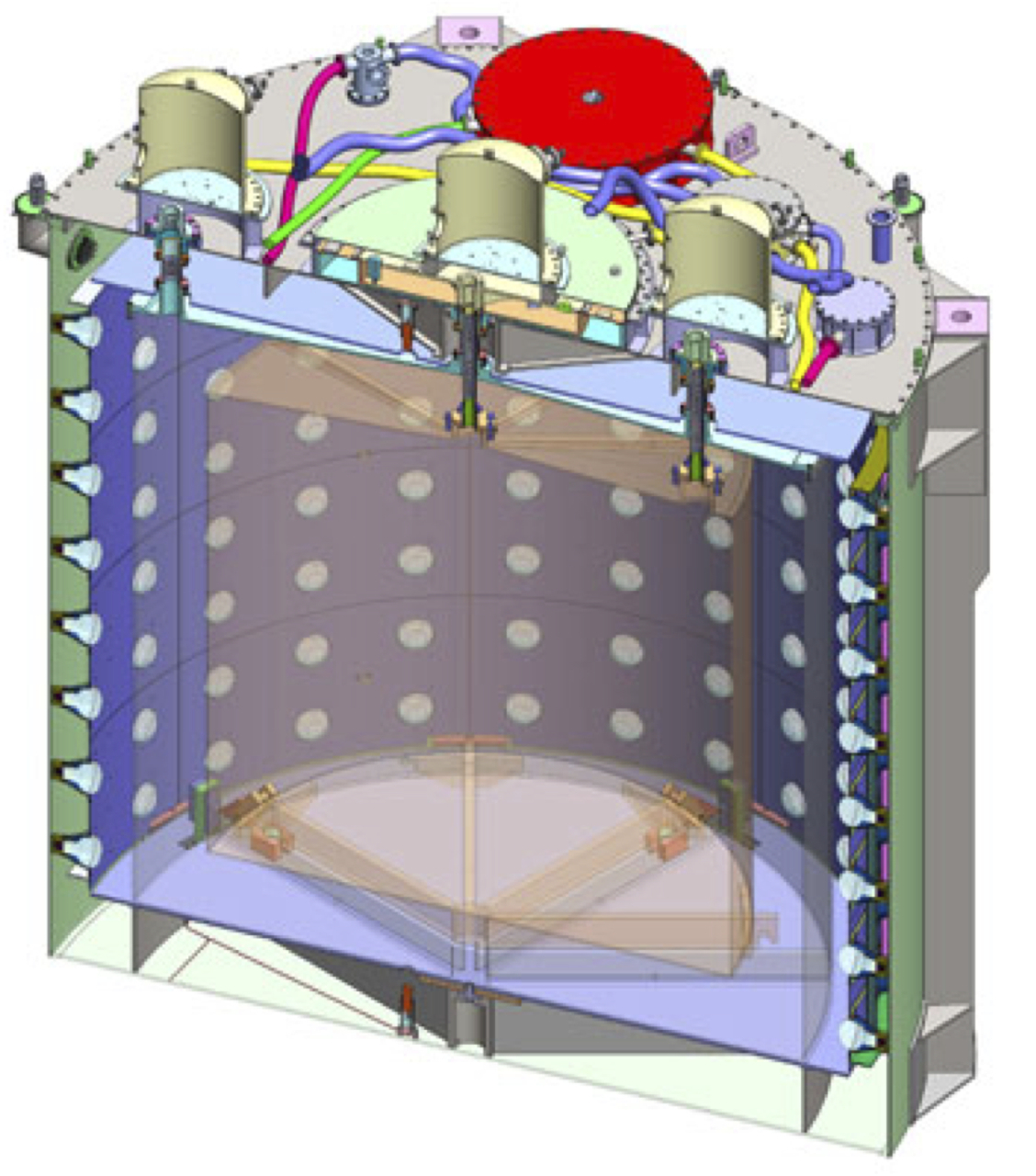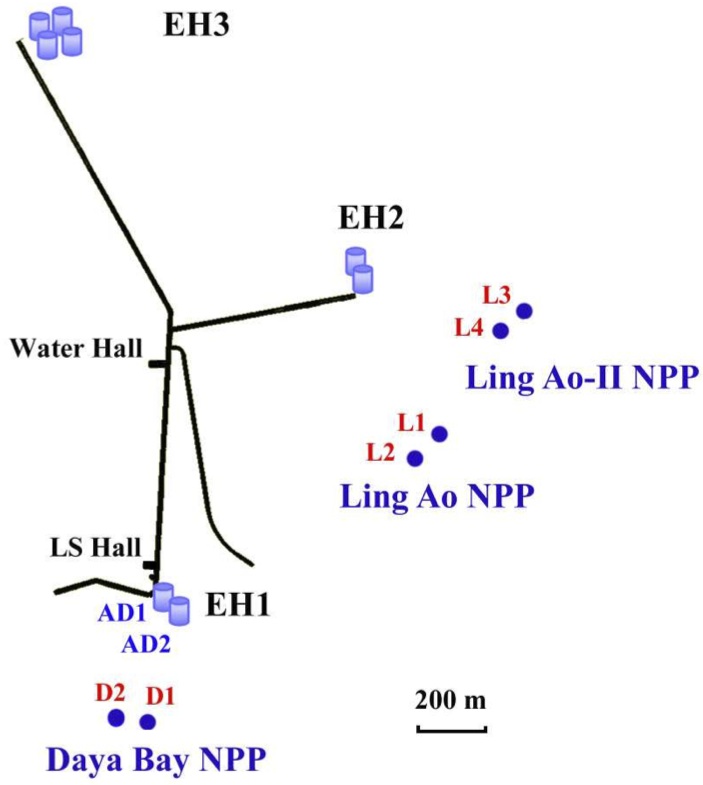 © 2010 The Regents of the University of California, through the Lawrence Berkeley National Laboratory.
© 2010 The Regents of the University of California, through the Lawrence Berkeley National Laboratory.
The Daya Bay Reactor Neutrino Experiment is a neutrino-oscillation experiment designed to measure the mixing angle θ13 using antineutrinos produced by the reactors of the Daya Bay Nuclear Power Plant (NPP) and the Ling Ao NPP. The project is the result of a collaboration between scientists from the United States, China, Chile, Czech Republic, Hong Kong, Russia, and Taiwan. Construction began in October 2007, and data taking began in August 2011. Knowing the precise value of θ13 will define the future direction of neutrino oscillation and CP violation investigations.
θ13
Neutrinos travel nearly at the speed of light and have extraordinarily small masses. As they travel, they oscillate between three “flavors”: electron neutrino, muon neutrino, and tau neutrino. The nature of this oscillation is described by a mixing matrix, called the Pontecorvo-Maki-Nakagawa-Sakata (PMNS) matrix, whose elements are specified in part by θ12, θ23, and θ13. The first two mixing angles are already well known. Daya Bay is designed to determine the final mixing angle, θ13, using low-energy electron antineutrinos.
Project Goals
The original goal of Daya Bay was to determine sin22θ13 with a sensitivity of ≤ 0.01 at 90% confidence level. With the discovery of a non-zero θ13 in 2012, Daya Bay now aims at measuring this mixing angle as precisely as possible. Our most precise measurement of θ13 to date is displayed at the top of this page.
The group took several steps to assure the precision of Daya Bay would exceed previous experiments. It was built near powerful nuclear reactors, which provide more power to the experiment. Larger detectors were built to utilize larger target mass. In order to suppress background, the experiment is located deeper underground and an active water shield is used to surround the detectors. Systematic uncertainties are reduced by optimizing the baselines and using the near and far detectors to make relative measurements.
Why Reactors?
The Daya Bay and Ling Ao NPPs supply electricity to the surrounding area by releasing nuclear energy in a process called nuclear fission. Antineutrinos and other particles are produced as a by-product of this reaction. The reactor thus provides the experiment with an intense, reliable source of low energy antineutrinos; a typical commercial nuclear reactor that generates 1GW of electricity can produce 6x1020 antineutrinos per second.
If you'd like to read more about the reactors, click here.
Antineutrino Detector

To determine θ13, the detectors measure the antineutrino rate indirectly by detecting the positrons and neutrons created from the inverse beta-decay (IBD) reaction:

whereby an incoming electron antineutrino collides with a proton in the liquid scintillator to form a positron and a neutron. The number of antineutrinos detected can then be related to θ13.
The image to the right shows one antineutrino detector. The central acrylic vessel contains a 0.1% gadolinium-doped liquid scintillator, the target. The gadolinium is very efficient in capturing neutrons. The target is shielded with a layer of undoped liquid scintillator, called a gamma catcher, for improving the efficiency of detecting gamma rays from the neutron capture and positron annihilation processes. Sources of background described in the section below are attenuated by a mineral oil buffer surrounding the gamma catcher. The energy of the incoming antineutrino is eventually converted to light, which is observed with an array of photomultiplier tubes, which are the light green bulbs in the picture.
A more detailed description of the detectors can be found here.
Background
Cosmic-ray muons, neutrons and gamma-rays are the main sources of background. The neutrons and gamma-rays can come from decays of natural radio-isotopes or interactions of muons in the nearby material. These particles can then interact with matter in such a way that resembles the IBD reaction to the detectors. For example, 8He and 9Li are radio-isotopes produced by the interaction of cosmic-ray muons with the target. These isotopes can decay and emit beta-rays (electrons) and neutrons. The mountain and the shielding around the detectors reduce the background significantly. The water shield is additionally used to identify muons by observing Cherenkov light. The cosmic ray muons are also tracked by the resistive plate chambers on top of the water shield. The background associated with the observed muons is then taken into account and corrected for in the measurement.
Site
The experiment is ideally located at the reactor complex in Daya Bay, China. The antineutrinos detected by the experiment are by-products of the Ling Ao and Daya Bay nuclear reactor cores, which are among the most powerful nuclear power plants in the world. The plants are approximately 1.1 km apart. In September 2010, the second phase of the Ling Ao NPP, Ling Ao II, became operational, bringing the total thermal power provided to the experiment by the three nuclear power plants to 17.4 GW, equivalent to approximately 6 GW of electricity.
Another benefit this location offers to the experiment is its excellent shielding. The complex directly abuts a mountain range that can afford protection from the cosmic rays. Tunnels in the mountain can provide between 90 m and 320 m of granite overburden to shield the detectors from cosmic rays, for distances between 360 m to 1.8 km from the reactor cores, respectively. These depths correspond to an approximate overburden of 250 and 860 mwe (meters of water equivalent), respectively.
More details about the location of the experiment can be found here.




